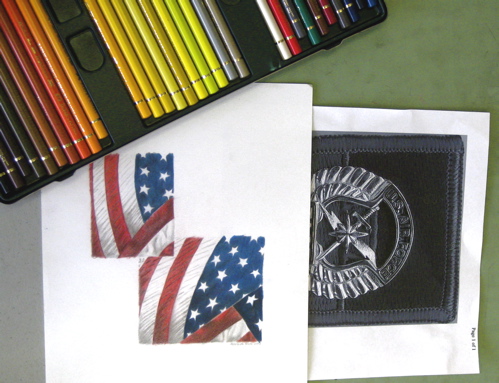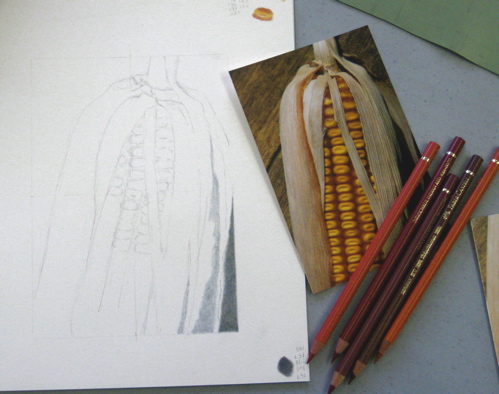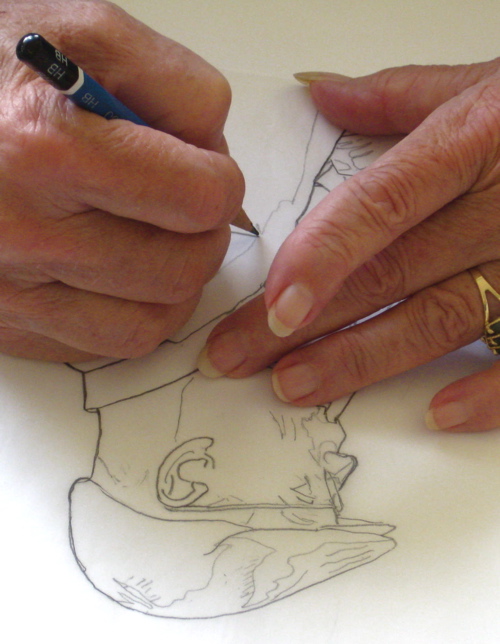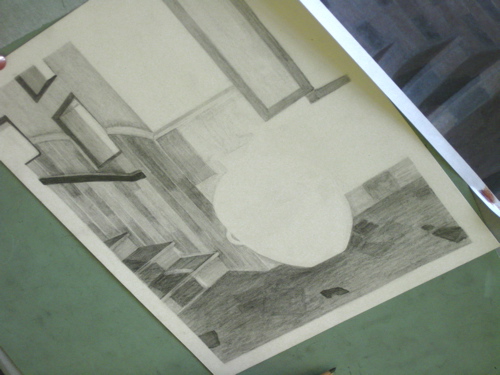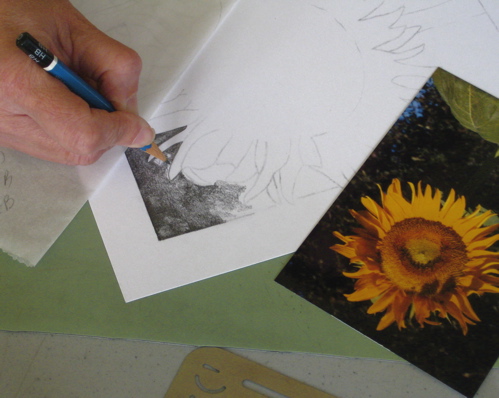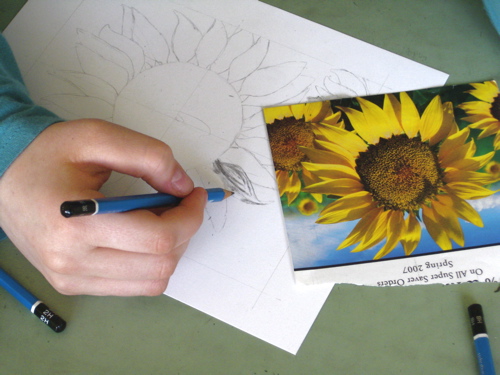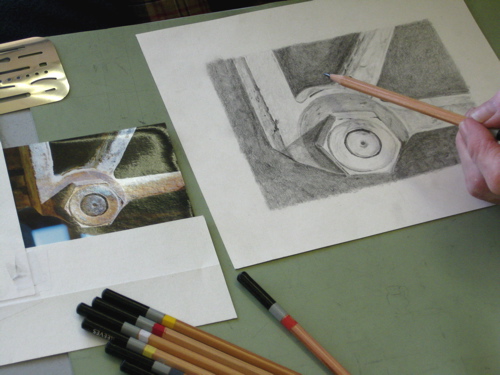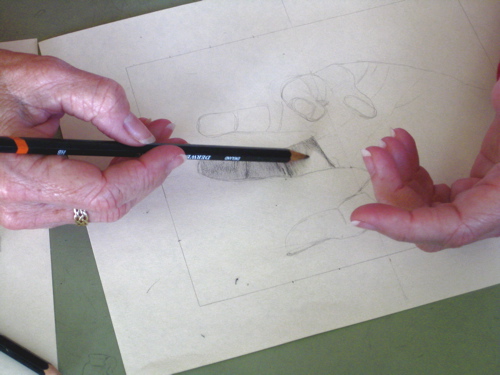Adalaide shows an usual ability to design art rather than just copy photographs. She works from her own photos, but occasionally uses images from other sources. This shows the flags as she designed them, and then she got the idea of adding the insignia from her brother’s Air Force patch in the background. After some thought and experimentation on tissue paper over the top, she decided to draw the patch as a separate piece. Planning on tissue paper over the top is a great method of designing changes to an existing piece of art.
Learning to draw, Chapter Nine
Before anyone graduates to colored pencil, they need to have skill with graphite. If one doesn’t understand the steps of drawing accurately, adding color to the mix is not going to improve one’s skill or one’s finished pieces. Wendy is very very good with graphite and has a wonderfully light touch that makes her colored pencil drawings both have depth and a glow. She has begun this picture with a gray scale underneath in gray colored pencils, not graphite. This method is called “grisaille” – pronounced “greeze eye”.
Learning to draw, Chapter Eight
This is the beginning of a colored pencil portrait. It looks like a heavy graphite outline, but this will go away as each color is applied. Mae is another traveler who works from her own photos. She looks very very carefully at each subject and crops and rearranges to make the best compositions possible. Being the proud owner of a new set of high-end colored pencils, she is also learning how to combine the colors to depict all the skin tones. Mae is a water-color painter who wanted to be more accurate in her shapes, and after 3 or 4 years with me, she is very accurate. Her paintings are reflecting her growing skill; this brings up the point that drawing is the basis of all art.
Learning to draw, Chapter Seven
This is in graphite and has been spray-fixed so it won’t smear. Next, the giant pot/vase thing will be done in colored pencil. Mary works from the photos she takes on her travels all over the world. Working from one’s own photos is best: no copyright problems and great familiarity with the subject are the advantages.
Learning to draw, Chapter Six
This is a very difficult photo from which to draw. It has a zillion different textures and it is only 3-1/2 x 5″ (Aren’t we spoiled by the 4×6″ size now?) Olivia has diligently worked her way from top to bottom, left to right. We have done a bit of redesigning because there are some particularly annoying shrubs that neither of us can figure out how to duplicate with a pencil. There is no need to be handcuffed by a photo – it is YOUR drawing, and you can do whatever you need to make it look best. Real Life Is Messy; Artists get to clean it up!
Learning to draw, Chapter Five
Here is another sunflower drawing. Shereen works from her own photographs, and she is quite experienced at drawing. She has the outline of the petals on the page, and is now working on the background. In general, a right-handed person shades from top to bottom and from back to front. This prevents the smearing problem that often occurs with graphite. And the good news is that a leftie can work from right to left and not smear either!
Learning to draw, Chapter Four
Remember I said, “Pick something you love, because you will be looking at it for a long time”? Kirby loves this band called “Slipknot”. It is her fourth drawing with me. She is doing a very careful and thorough job. This is creepy to me, so I mostly help her from across the table, viewing the drawing upside-down. This is a very helpful technique when learning to draw, or even after one knows how to draw. It bypasses the part of your brain that names an item which prevents you from actually seeing, and forces you to see just the sizes, proportions, shapes, angles, etc.
Learning to draw, Chapter Three
Here is another example of working from a photo. The first step is to decide size and placement; second step is laying out all the pieces with a very light outline. Figuring out how to space the flower petals took some organized thought. This is Maleah’s second drawing with me. Lots of people already draw some before taking lessons; some have never tried it but have always wanted to. People get a little nervous and say “I really don’t know how to draw”. My answer to that is “No need – that’s why you want lessons!” 😎
Learning to draw, Chapter Two
After drawing one’s hand, the next step is to work from a simple photograph. I ask students to bring in photos, preferably their own. This is because A. there aren’t copyright “issues” (why do I dislike that word so much??) and B. one is familiar with the subject and C. one apparently likes the subject if the trouble was taken to photograph it! I say over and over “Pick something you love, because you will be staring at it for a long time”.
This is Rod’s first pencil drawing. Really! It is a step by step process, and break it down into as many steps as it takes for someone to be able to draw. This includes lots of demonstrating and explaining and practicing on scratch paper.
Learning to draw, Chapter One
Learning to draw is about learning to see accurately and learning to handle the tools to depict what is seen. The first lessons are copying exercises, and then we move to drawing one’s own hand. This is how it can look:
All drawings start with the outlining stage. Here, Sara has her outline in place, and has begun to shade. We use a plexiglass viewing window to transform the 3 dimensional hand into 2 dimensions for the outlining process. This makes it easier to see what is really there. (It doesn’t show in this photo.)
